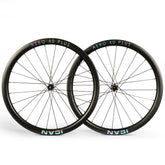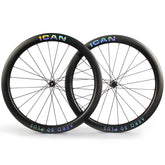Bikepacking guide for beginners
Bikepacking has been on the rise recently, and it's easy to see why. It's an adventure by bike, free of any restrictions, fast and light and with as little equipment as necessary. Exploring and visiting places you wouldn't have even thought of... Enjoying long single trails and having fun on the trails. You can plan your tour perfectly or just set off and see where your wheels take you. These are some of the reasons why bike packing appeals to the imagination of many.
The great thing about it is that it's so easy: you get on the bike you currently own and go exploring. However, our preferred bike is a gravel bike as it offers the most comfort and space for gear.
Improved internal routing X gravel bike
Three main factors determine the gear you need to take on your adventure:
- The weather
- The place where you drive
- Distance and travel time: You don't need the same equipment for a 2-day trip as for a 3-week vacation.
In this article we will give you some tips for your first bikepacking trip and what equipment you should take with you on your trip.
Camping and cooking equipment
If you have not provided accommodation for the night, you will probably need to bring accommodation for the night. A tent is the most logical option, but most tents are large, bulky, and heavy. Investing in a modern, lightweight tent is our first recommendation if you are going on multiple bike packing trips. Other (cheaper) options include a tarp or a bivy bag, but only if conditions permit.
A sleeping bag is a must unless you live in a warm climate. For a little more sleeping comfort, we recommend a camping mattress.
A fuel cell and an aluminum cup are your best friend for anyone who needs a coffee in the morning. Even if you're camping in a remote location, a small pot can provide a nice hot meal.
The most important thing: don't forget to take water with you; make sure you can refill your water bottles along the way. And if you know you'll be in a deserted area, make sure you have enough water with you.
Tools and spare parts
On big adventures in remote and impassable terrain, a mechanical problem is always inevitable. Be prepared with essentials for your trip. We've put together a tool kit that contains the basics in case you experience a mechanical failure far from civilization.First of all, a good multi-tool, preferably with a chain breaker, is a must. Try to buy a multi-tool with a 4mm, 5mm, 6mm and 8mm Allen key, preferably even a Torx 25 key. This means you will be able to loosen most screws on your bike.
Drivers who run tubeless tires should carry tubeless plugs in case of a flat tire. But not all punctures can be fixed with a plug. Bring a spare tube, some tire levers, and a small pump or even a CO2 cartridge. What's the point of changing the tube if you can't inflate it?
Finally, there are some small, lightweight items that you can carry with you that can help you in an emergency:
Attach a chain link to your brake hose with electrical tape in case your chain breaks.
Take an extra set of brake pads with you if you are traveling on very rough and steep terrain.
A spare brake bar is always a good idea, and take some zip ties with you. There are many uses for a cable tie on a bike to get yourself out of a sticky situation.
Of course, preparing the bike before setting off on a trip is invaluable; check your bike from top to bottom. Lubricate what needs to be lubricated, replace what you think needs replacing, and make sure your bike is in good working order before you set out on an adventure.
Bags
You need something to carry and store all of the things mentioned aboveMany companies make bike-specific bags (handlebar roll, frame and seat bags). These bags are designed to fit your bike well and usually have additional customization and adjustment options such as straps and tags or are even modular... But these bags can be quite expensive. Use a few panniers and straps if you want to go on your first trip without breaking the bank.
There is also the option to carry a backpack, although we advise against traveling with one. Try to ride as light as possible. But in some cases it has its purpose:
- To store additional equipment.
- Bring additional clothing.
- For camera equipment or even if you don't have bikepacking bags yet.
Some important things and extras not to forget
We've already told you a lot of things you should take with you on your trip, but there are a few more important things you should add to your packing list to make your life a little easier and sometimes even safer.
The first point is light; always take light with you. If you're riding at night, you'll need bike lights to keep you visible and safe on busy roads. It's best to attach a lamp to your handlebars and a helmet lamp so you can be seen better. Let's say you're camping in the middle of nowhere. A powerful headlamp will make things easier for you. This means you can cook, set up your campsite and control your bike with both hands.
Next up is a power bank and USB cable. Here too, access to electricity and chargers is limited when wild camping. A battery pack is essential to power your devices (cell phone, camera, light,...).
If you plan to stay overnight, take extra clothes with you, but only the essentials for your trip:
- A puffer jacket
- Lightweight hiking pants
- Long sleeve tops
- Additional footwear for the evening
- A rain jacket
- Arm and knee warmers
- Replacement socks
Also pack a small first aid kit in one of your bags. It's not uncommon to cut your arms or legs on thorns. And last but not least: don't forget your toiletries, toothbrush and toothpaste!
If you still have room in your bags, fill it with groceries. You can never have enough to eat when you have a very long journey ahead of you.
Now get going and enjoy your first bikepacking tour and take your time. Enjoy the ride and the view. There's no need to invest in fancy equipment right away; start with what you already own and build from there. Remember: pack light; You only need the bare essentials.






